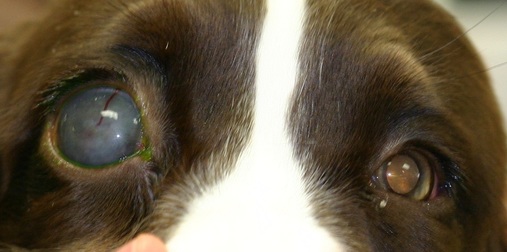GlaucomaWhat is it?
Glaucoma is a disease classified by an increased pressure in the eye. The fluid in the front of the eye (aqueous humor) helps maintain the shape of the eye and nourishes the tissues inside the eye. The aqueous humor drains out of the eye and into the bloodstream through a drainage angle. The balance of aqeous fluid production and drainage is responsible for maintaining pressure in the eye. Glaucoma occurs when the drainage angle becomes partially or completely obstructed and the aqueous being produced cannot exit properly causing pressure to build in the eye. Glaucoma is characterized as either primary or secondary. Primary glaucoma is an inherited condition that occurs in many breeds including the Cocker Spaniel, Bassett Hound, Shar Pei, Chow Chow, Boston Terrier, Beagle and several other breeds. Primary glaucoma is often seen initially in one eye but eventually affects both eyes. Secondary glaucoma occurs as a result of another disease or trauma that causes the drainage angle to become blocked. Common causes of secondary glaucoma include trauma to the eye, inflammation, a luxated lens, intraocular hemorrhage and inflammation from cataracts. What are possible complications of glaucoma? If left untreated, this pressure can damage the retina and optic nerve leading to permanent blindness in as little as 24-48 hours. Immediate treatment is crucial to decrease the intraocular pressure to try to maintain vision. |
Symptoms |
Common signs of glaucoma can include:
-pain (squinting, rubbing at the eye, loss of appetite, hiding) -redness -cloudy cornea -dilated pupil -enlarged eye -sudden blindnesse. |
Treatment |
While there is no cure for glaucoma, every effort is made to extend vision and comfort as long as possible. Both eyes should be monitored daily for changes. There are various oral and topical medications aimed at opening the drainage angle or decreasing the output of aqueous. The doctor will make a treatment plan for your pet based on the diagnosis. It is important to follow this treatment plan as closely as possible. Your pets intraocular pressure will be monitored frequently at first to make sure the medication schedule is working. Unless otherwise directed, please make sure all the medications are applied the morning of your next appointment. .
|

